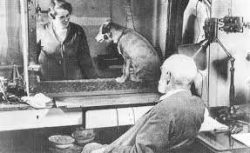Psychology D.E.A.R. moment – Pavlov’s dogs
Year 13 psychology students were fully engaged during our recent Drop Everything And Read event on Wednesday. They read more deeply about Pavlov’s famous study into conditioning...
Filter by Category
Filter by Author

























































































































































































Year 13 psychology students were fully engaged during our recent Drop Everything And Read event on Wednesday. They read more deeply about Pavlov’s famous study into conditioning...
Posted by Gabriela Zhelyazkova

It has been a very exciting couple of weeks for Year 12 childcare students as they have embarked on their work placements. These placements, an integral part of the course, allow...
Posted by James Burley

Another Powerful Strategy to Maximise Progress Parents and Carers – do play your part over half term! At Bushey Meads all staff and students know the importance of work...
Posted by Jeremy Turner

Dear all, Please find below the SEND ‘Tip of the Month’ for October 2021. As a school we have a number of students with a diagnosis of Autism and Pathological Demand...
Posted by Roa Dillon

Posted by Di Mcildowie

This week, the year 7’s have been learning about the different patterns in a sequence. Once they have gained that knowledge, we looked at where sequences were applied in...
Posted by James Donovan

Well done to everyone who attended Debate Club over the past two weeks. The debating was superb and we had lots of fun too. If you would like to join our BMS Debate Club, come...
Posted by Sarah Brown

MFL Faculty nominated 10 Maple the winner of the European Day of Languages photo competition. This involved CDC groups taking a photograph of a foreign dish (or something that...
Posted by Hilarie Charles

Bushey Meads to Oxbridge This year, year 13’s ambition and motivation stood out as the year with the most Oxbridge applications so far in BMS history! The sixth form common...
Posted by Gabriela Zhelyazkova

It was lovely to welcome so many parents and carers to our Learning Support Information Evening hosted in the Main Hall by our outstanding SENDCo Roa Dillon who is one of the key...
Posted by Jeremy Turner

Year 13 psychology students were fully engaged during our recent Drop Everything And Read event on Wednesday. They read more deeply about Pavlov’s famous study into conditioning behaviour, known as Pavlov’s dogs. Pavlov conditioned dogs to associate food with the sound of a bell so that they only had to hear the bell and then started to salivate. This is known as ‘classical conditioning’ in psychology and is used to explain how people (and animals) can be conditioned into or out of certain behaviours. This theory is also used to help treat phobias.
The Pavlov article revealed some shocking facts about the ethics and reliability of Pavlov’s work; it also exposed some myths. There was no bell, a metronome was used as the stimulus in his experiments. Pavlov’s lab used hundreds, possibly thousands of dogs which were collected for Pavlov by street thieves in St Petersburg. The dogs were poorly treated being starved for upto six days before the experiments and these would last for hours at a time. Some experiments involved conditioning the dogs using electric shocks or metal spikes as the stimulus. This shocking revelation of mistreatment goes against Pavlov’s assertion that the dogs were well treated: ‘normal, happy and long-lived’.
Another revelation from the article was that Pavlov used his dogs to produce canine gastric juice (from their stomachs) which was extracted, bottled and sold as a cure for indigestion! In 1929 the dogs produced 4,500 litres which was a profitable business
More shocking to his reputation as a serious scientist was the fact Pavlov also suppressed his results. The more dogs he conditioned, the more he realised that they actually responded in different ways due to their individual characters. Pavlov and his team identified 23 different personality types in the dogs and that they behaved differently on different occasions. But Pavlov was unable to come up with a personality theory to explain this, so he simply kept this aspect of research hidden. This has left us with the more simplistic view that the dogs were passive objects responding happily to the harmless bell conditioning stimulus. Our D.E.A.R. moment allowed Y13 students to see a more complex and unethical side to Pavlov’s famous research.

The traditional wedding in the UK somewhat resembles the fairy tale “something borrowed and something blue” wedding. But at BMS we have been skipping the conventional and learning...

At the end of the Spring term, teachers in the humanities and social sciences faculty like to look back at what has been achieved so far this year. It may be a more unusual year...